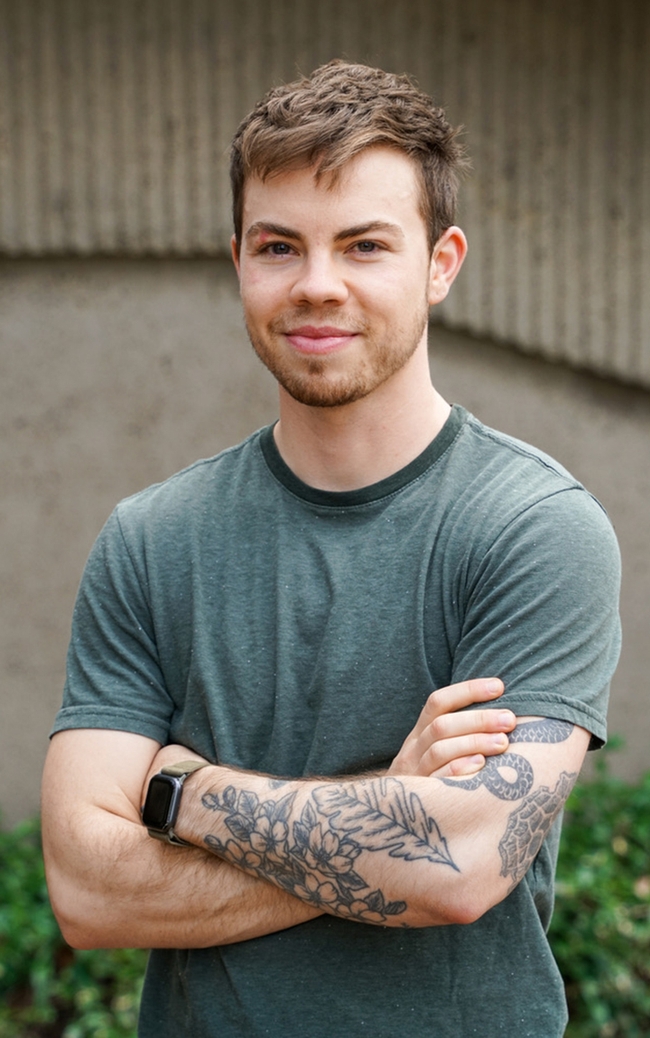
if you hike a short distance up a meandering trail, you'll see a landscape of turrets, the work of solitary, ground-nesting digger bees, Anthophora bomboides standfordina.
The nests remind us tiny sandcastles. The female bees did that!
In the early spring you'll see the bees nectaring on wild radish and other flowers.
These digger bees are found along the sandy cliffs of beaches along the Pacific Coast, not just Bodega Head. They're sometimes called the “Stanford bumble bee digger” because its subspecies name, “stanfordiana,” refers to a 1904 Stanford University collection.
They are bumble bee mimics; they mimic the yellow-faced bumble bee, Bombus vosnesenskii.
It was Robbin Thorp (1933-2019), distinguished emeritus professor, UC Davis Department of Entomology and Nematology (ENT), who alerted us to them. He studied them at the Bodega Marine Reserve and loved to share his research.
So, on every trip to the Bodega Head, we scramble up the trail to see what the bees are doing. Of course, when they're overwintering, we don't see them at all, just the turrets.
Fast forward to today. On the ENT website, we posted a research story today that began 'Microbes found in the immature stages of a solitary bee that nests in sand cliffs along Pacific Coast beaches may be helping the bee defend itself from pathogens and protect it from cold stress, according to newly published research led by microbiologist Shawn Christensen of the Rachel Vannette Lab, UC Davis Department of Entomology and Nematology."
The research publication, “Symbiotic Bacteria and Fungi Proliferate in Diapause and May Enhance Overwintering Survival in a Solitary Bee,” appears in the current issue of the journal, International Society for Microbial Ecology (ISME), and is posted on the National Library of Science website.
“Contrary to what has previously been assumed and found in other systems, we found that dormant--also called diapausing--bees have more abundant symbiotic bacteria and fungi,” said Christensen, a doctoral candidate and the 2024 recipient of the Merton Love Ecology and Dissertation Award, an annual award that celebrates the university's most outstanding doctoral dissertation in the fields of ecology and evolutionary biology. He's scheduled to receive his doctorate this month.
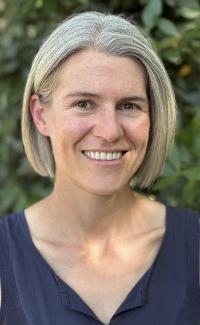
The six-member research team, including colleagues from Cornell University, UC Riverside and the University of Arizona, also found “that the microbiome of this solitary bee is very consistent--the same taxa appear in most brood cells, in similar proportions,” said Christensen. “This is uncommon in solitary species, which normally have variable microbiomes due to lack of social transmission. We are still exploring this unique aspect!”
Vannette, associate professor and vice chair of the department and an international leader in microbial ecology, researches interactions between plants, insects and microbes. She is a principal investigator of a National Science Foundation grant that funded the project.
“Previous work on bee-microbe interactions has shown how gut bacteria benefit honey bees and other corbiculate social bees but these microbes are limited to social bees,” Vannette told us. “We wondered if solitary bees also associate with beneficial microbes and uncovered this previously undescribed partnership between bees, fungi and bacteria. This study opens up new questions in bee ecology and host-microbe interactions: how do solitary bees maintain specific associations with bacteria and fungi? What chemistry are Streptomyces using to suppress fungi? Does this association benefit bees? We think it is likely but ongoing work will examine these questions.”
“We are also thrilled to find this unique symbiosis in a bee species that has been well-studied by previous faculty at UC Davis, including RobbinThorp,” Vannette said. “UC Davis nematologist Harry Kaya, with graduate student Robin Giblin, also described Bursaphelenchus seani, a nematode that inhabits Anthophora bomboides. Our lab is also investigating links between the brood cell microbiome and the nematodes in this bee species.”
Other co-authors of the paper are
- Quinn McFrederick, assistant professor at UC Riverside who studies symbionts (pathogens, commensals, and mutualists) of wild and solitary bees
- Bryan Danforth, professor at Cornell University, who specializes in bee systematics and evolution
- Stephen Buchmann, pollination ecologist affiliated with the Departments of Entomology and of Ecology and Evolutionary Biology at the University of Arizona
- Sriram Srinivas, then a UC Davis undergraduate researcher in the Vannette lab
Check out Thorp's presentation on digger bees that he delivered at the “Proceedings of the Symposium on Biodiversity of Northwestern California” in October, 1991, in Santa Rosa.
Also check out the wonderfully done PBS Deep Look Video, This Bee Builds Sandcastles at the Beach.
Let's dig the digger bees.
Attached Images:
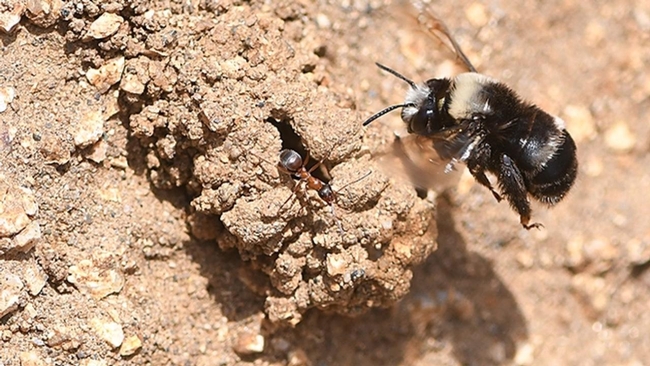
A digger bee, Anthophora bomboides standfordina, heading to her nest at Bodega Head. Note the ant. (Photo by Kathy Keatley Garvey)
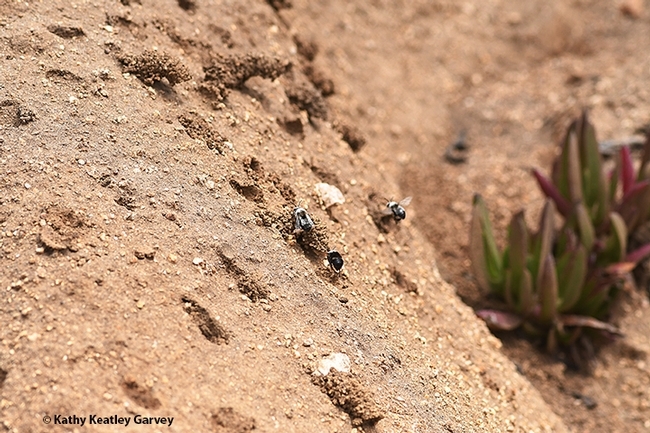
At Bodega Head you can see turrets made by solitary, ground-nesting digger bees, Anthophora bomboides standfordina. (Photo by Kathy Keatley Garvey)
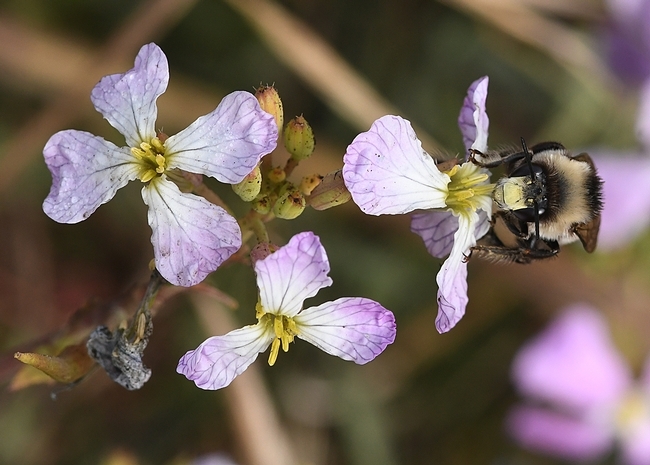
A digger bee, Anthophora bomboides standfordina, nectaring on wild radish. (Photo by Kathy Keatley Garvey)
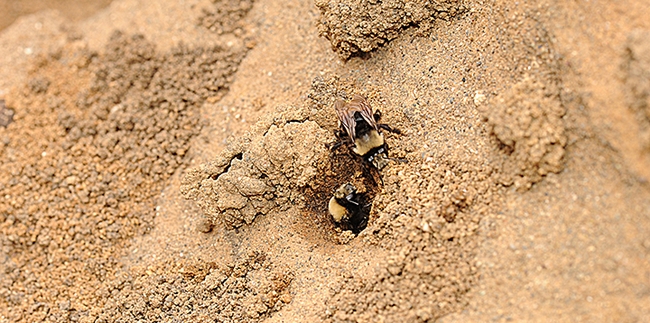
Here I am! Anthophora bomboides standfordina, at Bodega Head, Sonoma County. (Photo by Kathy Keatley Garvey)